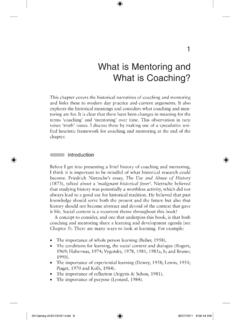Transcription of Social Influence: Conformity, Social Roles, and Obedience
1 7 Social influence : Conformity, Social Roles, and ObedienceCHAPTER 7 Social influence : ConfoRmiTy, Social RolES, And obEdiEnCE3 You are not alone if you recall middle school and high school as hard chapters in your life. It is a time when Social influence applies constant peer pressure (Brown, 1982) and popularity depends on knowing and conforming to unwritten rules. Fortu-nately, as we grow older, our possible Social roles expand well beyond the boundaries of high school stereotypes around sports, geekdom, or the Social roles still influence us; adults at Social gatherings tend to ask, What do you do for a living? to identify individuals and begin to form impressions. While sometimes we can feel the pressure of too many or conflicting Social roles ( , for women, Arthur & Lee, 2008), our deeper commitments to certain roles (as parent, employee, lover, or friend) are a form of Social influence that stabilizes society we grad-ually become the gears that keep societies up and can be dangers as we negotiate our way into new Social roles, especially when those Social roles require Obedience to an authority.
2 Conforming and obeying authorities appear to be wired into the human experience because they keep society functioning. However, they also are associated with the dark side of Social most disturbing, early observations about Social influence were connected to World War I and then again to World War II and the Holocaust. A common defense for the mass torture and murder of Jews, Communists, homosexuals, the disabled, and others was simply, I was just following orders and I didn t do anything unique; every-one else did the same thing. A century of basic research in Social psychology has signifi-cantly increased our understanding of Social influence , but there is still much more to be reading this chapter, you will be able to answer the following questions:Core Questions1. What types of Social influence exist?2. Why and when do we choose to conform?3. How do Social roles change our behavior ?
3 4. What can we learn from Milgram s experiments on authority?Learning Objectives1. Compare and contrast implicit versus explicit Social Differentiate between informational and normative Social pressures to Analyze how Social roles lead us to conform to situational Explain the person, procedures, and competing interpretations behind the Milgram experiments on TYPES OF Social influence EXIST? Learning Objective 1: Compare and contrast implicit versus explicit Social influence describes how our thoughts, feelings, and behaviors respond to our Social world, including our tendencies to conform to others, follow Social rules, and obey authority figures. Social influence takes two basic forms: implicit expectations and explicit expectations. Implicit expectations are unspoken rules. Like the unwritten laws of middle school, implicit expectations are enforced by group norms.
4 For example, no Social PSYCHOLOGY4one has to tell you that you will likely be expected to dress differently at formal religious events com-pared to attending a retro grunge rock expectations can be further subdi-vided into two types. The first is conformity, which occurs when you voluntarily change your behavior to imitate the behavior of your peers. Twenty-five years from now, you will probably look at a current picture of yourself and wonder how you could have made such terrible fashion choices way back when. At the time, you were probably wearing what every-one else was second form of implicit Social influence comes from Social roles, or expectations from a group about how certain people are supposed to look and behave. We share stereotypes about how elementary school teachers, rock musicians, clergy, and presidential candidates publicly engage with others. These expectations are implicit because while everyone knows the rules, they aren t necessarily written down or implicit expectations, explicit expectations are clearly and formally stated not at all subtle.
5 There are also two forms of explicit expectations: compliance and obe-dience. Compliance occurs when you behave in response to a direct or indirect request. When healthy graduate students asked people on a New York City subway to give up their seat, about two thirds of the subway riders complied (Milgram & Sabini, 1983) just because someone asked. With compliance, there isn t necessarily any threat of pun-ishment for not doing the behavior it is a request, not a contrast, Obedience occurs when you behave in a particular way because some-one of higher status has ordered you to do so. It might be your boss at work, a parent, or a professor at school; in any case, the expectation is stated clearly and often accompanied by some kind of Social punishment if you fail to obey. In general, Obedience can be con-sidered a more extreme version of Conformity Social RolesExplicitexpectations Compliance Obedience FIGURE Implicit expectations (conformity and Social roles) plus explicit expectations (compliance and Obedience ).
6 Sometimes, these four forms of Social influence Landmesser defied Social pressures to give the Nazi salute, probably because he had fallen in love with a Jewish woman, Irma Eckler. He was banned from the Nazi party after he and Eckler became engaged, and they were later denied a marriage license. If you want to learn more, several websites describe his quiet heroism in fighting against Social pressures and its tragic 7 Social influence : ConfoRmiTy, Social RolES, And obEdiEnCE5 Social Norms and the Herd MentalityAre you more of an independent thinker or a conformist? Our impulse to conform begins much earlier in life than you might imagine. Infants will imitate others when they are only 2 to 3 weeks old (Meltzoff & Moore, 1977, 1989). Growing infants will automatically clap when others clap; as small children, they will whisper back when others whisper to them, and a little later they will imitate one another s eating habits (Johnston, 2002).
7 As we grow, we absorb these behav-iors as Social norms (also called group norms) rules that indicate how people are expected to behave in particular Social sit-uations. There is an implied payoff for conforming to Social norms for humans, as well as many other species. It increases our odds of meeting, mating, and protecting our offspring until they reach their own reproductive maturity (Buss & Kenrick, 1998). Put another way, however, the reverse is also true: If we fail to meet Social norms, our chances of being accepted by the group decrease and our stubborn independence reduces our chances of finding a life that s only part of the story behind group norms. Group norms can also create a herd mentality (the tendency to blindly follow the direction your group is moving toward). Suddenly you may find yourself proclaiming strange and dangerous beliefs. Going along to get along can also lead to authoritarian leaders, and a herd mentality can make small conflicts mushroom into dangerous confrontations.
8 For example, prior to World War I, both sides recruited many thousands of enthusiastic volunteers. Both sides were certain that the conflict would be short and glorious. This war wasn t short and it wasn t glorious. The herd mentality helped recruit and then destroy almost an entire Is ContagiousConforming is contagious. For example, it can be awkward to attend your first holiday meal with new in-laws if no one tells you that Grandpa always sits in a particular chair or that the holiday meal, announced for 2 , is never served until 4:30. Your new family members do not have to say anything to communicate their group norms, how-ever. Instead, you observe that at 2 , the dining room table isn t set, the cooking is just getting started, the teenagers are just getting out of bed, and no one else seems surprised that the meal is so late. However, to their way of thinking your new family s Social norm the meal is right on time.
9 Dinner is at 2 really means, Come on over sometime in the after-noon; we ll start cooking. Your Social network (new relatives) will guide you to conform according to the cultural expectations that your new spouse probably forgot to mention (see Gulati & Puranam, 2009). The Social norms practiced by your new relatives pro-vide specific but implicit guidance about how you are expected to Contagion. One of Social psychology s simplest yet strangest experiments demonstrates the importance of group size in Social contagion, the spontaneous I don t want to belong to any club that will accept people like me as a member. Groucho Marx (1967)In a herd of animals, each has to move in the same direction or they might get trampled. Can this be a metaphor for human tendencies to conform? Social PSYCHOLOGY6distribution of ideas, attitudes, and behaviors among larger groups of people.
10 One per-son on a busy New York City street stopped on the sidewalk and stared up at a sixth-floor window of a building (Milgram, Bickman, & Berkowitz, 1969). That s all it took to start a small Social contagion. Make no mistake: There was nothing special in the window just some distant, difficult-to-see people looking back at only 60 seconds, the first person stopped staring and moved on. After pauses long enough to allow new sets of participants to enter the scene, groups of 1, 2, 3, 5, 10, or 15 confederates (members of the research team pretending to be among the partici-pants) stopped and repeated the procedure while researchers discreetly made a movie of the crowds that formed and dissolved. They discovered that the bigger the initial crowd, the more compelling it was for other people to join s the apparent take-home message from this odd experiment: The mere exis-tence of the crowd justified conforming to it.














